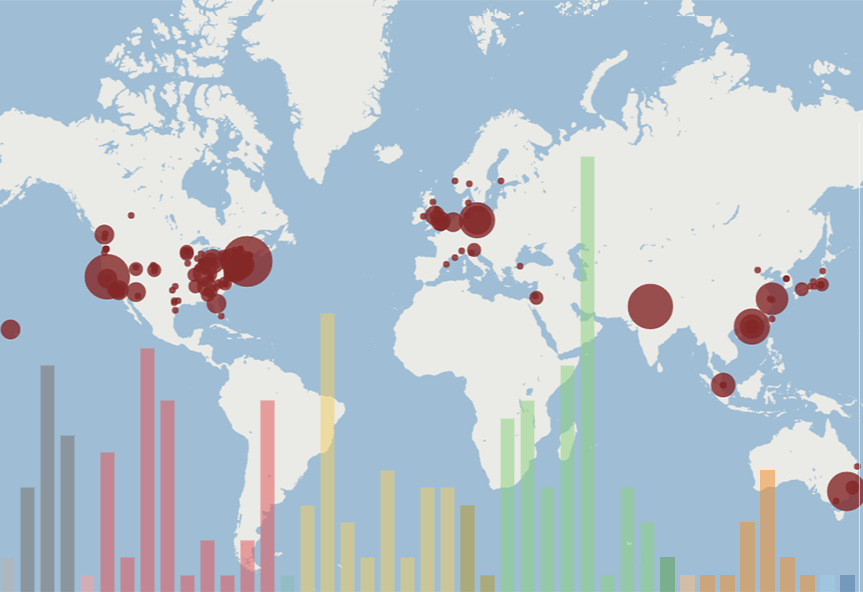
East Asia-related Job Market Data Report (2019-2020)
Published May 1, 2020
This page compiles information and visualizations on academic-oriented job postings related to East Asia and Japan for the 2019-2020 season (from roughly August to April).
The ongoing state of crisis in academia over the last decade has fostered numerous conversations among academic circles and publications about the viability of continuing to graduate a high volume of PhDs within institutional environments that offer fewer and fewer tenure-track positions. From these despairing depths, incredibly valuable dialogues have been born on what it means to “go alt-ac” or “academic adjacent” and the cost of short- and long-term contingent positions on career and life stability, mental health, teaching, research practices, and the larger academic profession.
Amidst these questions, some have tried to find silver linings; Inside Higher Ed, for example, declared that the job market for historians was stabilizing, while the image of what “stable” looks like continues to be bleak:
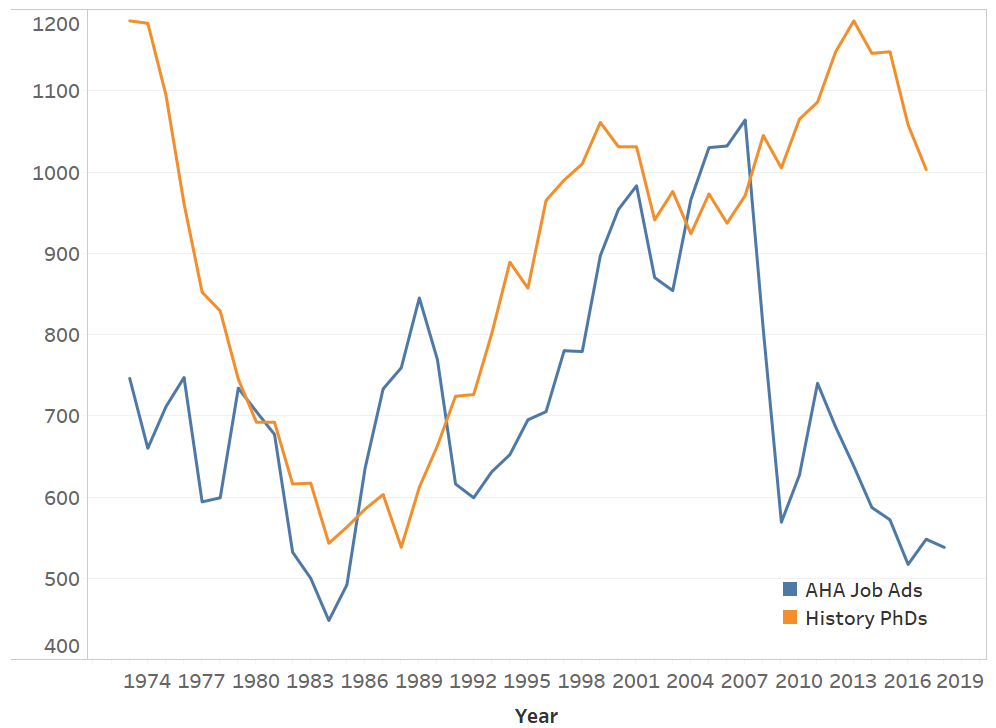
Everyone wants to know, of course, what this means for their own field of study. In East Asian Studies, and especially from the perspective of Japan Studies, there has been much interest in how the field has changed from its earliest days under postwar and Cold War politics, through the “Cool Japan” boom, and into our current circumstances with the balance of hard and soft power shifting yet again in East Asia. At the 2019 Association for Asian Studies (AAS), the “Death of Japanese Studies” panel began a conversation about the issues currently facing Japan-related scholars and educators. In anticipation of continuing this dialogue through The “Rebirth” of Japanese Studies roundtable I organized for AAS 2020 (now converted to a virtual format), I compiled the data on East Asia- and Japan-related job postings provided on this page. I organized data into seven categories: Location, Desired Region, Desired Discipline, Period, Track, School Type, and Public/Private. Within each category, I created a labeling system for visualization.
The academic job market will be even more challenging and unpredictable in the coming years, as many institutions have announced hiring freezes while they attempt to recover from the financial aftermath of COVID-19. I hope that the information provided on this page and the virtual roundtable will facilitate further dialogue on current and future developments in the Japan and East Asian Studies fields.
About the Data: Sources
The data gathered for this exploration originated from several sites:
This data should NOT be considered 100% comprehensive (see caveats below), merely reflective of information provided on some of the most commonly-used job search portals for academic postings related to East Asia.1
About the Data: Caveats
First, let me say that data is messy. This is a reflection on the job ads themselves, which are even messier. A job ad might ask for something fairly specific, like a historian of contemporary China focusing on the environmental humanities, or simply list “East Asian Studies” with no additional information on a desired time period, specialization, or other qualifications. Because job ads are inconsistent in the terminology used to describe some academic positions, I have chosen not to do a vocabulary-based comparison on desired disciplinary expertise. For the purposes of producing this dataset, job ad language was taken at face value, and cannot account for any internal criteria that informed the scope of searches. How data is represented is also interpreted through the compiler. Others might have organized or categorized this data differently than I have.
The data presented here is also reflective of both an English-language and North American bias, as many of the sites examined tend to focus on those positions, and others presented in other languages are only infrequently submitted to these venues. Some postings also may pass through informal channels only or through alternative lists to which I do not have access. Furthermore, some schools either do not or cannot afford to post their job openings through more widely-known channels.
This list also may not be exhaustive with regards to jobs that one might consider “alt-ac” or “academic adjacent,” as I focused to the best of my ability on those ads that readily circulated among Asian Studies circles. In some cases, job postings may have been removed after their deadline passed or when the position was filled, leading to the disappearance of more specific information on their content. I incorporated advertisements posted between June 1, 2019 and April 29, 2020. Data was collected throughout spring 2020.2
Please note that because of the COVID-19 pandemic, some institutions cut their hiring seasons short in March 2020.
About the Data: Cleaning and Organization
In an effort to produce meaningful visualizations comparing different job ads, I created seven different data categories. To review what each category and its accompanying labels mean (and how they were determined), click each of the tabs below.
The geographic location of the hiring institution.
The geographic regional coverage for which the job ad identified a preference. East Asian Studies and many humanities fields cite a primary region or nation of interest in their advertisements, whereas many social science fields have begun to replace regional or national focus with methodological preferences. This category was narrowed down from the ad content when possible. For example, if an ad listed “East Asian Studies/Asian Studies” for the title or topic of the position, but specified “preference for a candidate who can teach modern China,” then this posting’s “desired region” was labeled as “China.” Ads that included a specific combination of locations, such as “Asia/Africa” are identified separately. Job ads that were vague, such as positions in “non-Western” or “global” studies were not included. Northeast Asia was the central focus of job data collected. - East Asia/Asia
- Japan
- China
- Korea
- Taiwan
- China/Japan
- Japan/Korea
- Asia/Africa
- China/South Asia
Data on the desired discipline identified in job ads was divided into labels that best distinguish the responsibilities of the position, based on the department hiring and/or description of the qualifications. Disciplines for which few postings were area-specific are combined in the interest of visual legibility. The social sciences, in particular, pose challenges to data collection, as they do not often advertise region- or nation-specific positions. Two labels are divided in some visualizations: “Literature & Culture” and “East Asian/Asian Studies.” Often generalist positions in East Asian Studies are filled by specialists in literature and culture, complicating this division. Here, I have chosen to separate general positions that do not list a specific interest in literature/culture from job ads that specifically ask for a literature/culture specialist. Similarly, although there is often overlap between generalist instructors and language instructors at small institutions, the “Language” category applies to jobs exclusively looking for language instructors. - East Asian/Asian Studies
- Language
- Literature & Culture
- History
- Film/Media Studies
- Art History/Architecture/Urban Studies
- PoliSci/Anthro/Socio
- Religious Studies
- Archaeology
- Admin/Program Director
- Curator
- Library
- Social Studies/Education
- Business/Investment
The time period of the specialist desired in the job advertisement. - modern
- premodern (early modern [c. 18th/19th cen] and before)
- any (not specified or no preference)
- N/A (e.g.: language instructors)
The track/security of the position. Contingent positions have been divided into jobs that are non-tenure track positions and postdocs, as the former typically applies to visiting or adjunct positions and the latter often applies to research positions, sometimes with minimal teaching responsibilities. - TT (tenure track)
- non-TT (non-tenure track, including jobs to which this term does not apply)
- postdoc (non-tenure track, contingent position)
The labeling of institutions is based on its research output and degree-granting programs. This is perhaps the most problematic of the data organized, as, for the sake of comparison, each institution has been forced to fit into the rough equivalent of the US categories based on The Carnegie Classification of Institutions of Higher Education. The Carnegie classifications do NOT consistently correlate with institutional rankings (also problematic). For UK-based institutions, I established R1 equivalents based on the Russell Group categories, and for Australia, the Group of Eight. For universities in Asia and Europe, I consulted with colleagues based in those areas and provided a best guess based on anecdotal advice. I fully acknowledge that these distinctions are problematic and are often considered subjective. The most meaningful observations may be derived from considering the extremes-- whether jobs appear more often at very large doctoral degree-granting institutions or small liberal arts institutions. - R1 - very high research, doctoral program
- R1 regional branch - branch campuses of R1 institutions located in the US or abroad
- R2 - high research, doctoral program
- D/PU - Doctoral/Professional Universities
- M1 - high research, masters program
- M2 - medium research, masters program
- SLAC - small liberal arts college
- N/A
The type of institution. N/A indicates it is something different from a typical academic degree-granting institution, such as a language training school, etc. - public
- private
- N/A
The Data
Please review the caveats and labeling system provided above before viewing the data in order to best understand how and why it has been cleaned and organized as presented below. Due to the temporary nature of job ads circulated online, particularly on platforms that delete completed postings or do not provide access to their posts after a certain number of months, I have chosen not to attempt a comparison with last year’s job season, as it may be highly inaccurate.
Below, I have created numerous (though not necessarily exhaustive) visualizations based on my data using Tableau Public. Please note that postdocs were counted by the number of positions offered at a single university. For example, Yale University’s Council on East Asian Studies hires four postdocs per year, so this is counted as four positions.
The following visualization is an interactive map of all East Asia-related job postings by discipline, track, and location. Clicking on information in the upper portion of the visualization or on the map below will generate its linked data across other fields. Hover over data points on the map to reveal information on the data point provided. Zooming in or out is also possible. Points on the map are sized to frequency, so a place with more jobs postings will appear larger than other points. Click the title of the subcategory you’re filtering or white space on within the area of the visualization you originally selected to void your selection and start over. Tableau Public can be finicky, so it may take a little experimentation. If interactive visualizations lag or generate an error, please refresh the page.
Note: Two errors have been identified since this page's publication that provide an apt example of the perils of data compilation: "Turkey" has been mistakenly identified as "Istanbul" in the locations list, and Hampden, Sydney College is listed as in Australia, although its geolocation data appears correctly in the map, locating it in Virginia, United States.
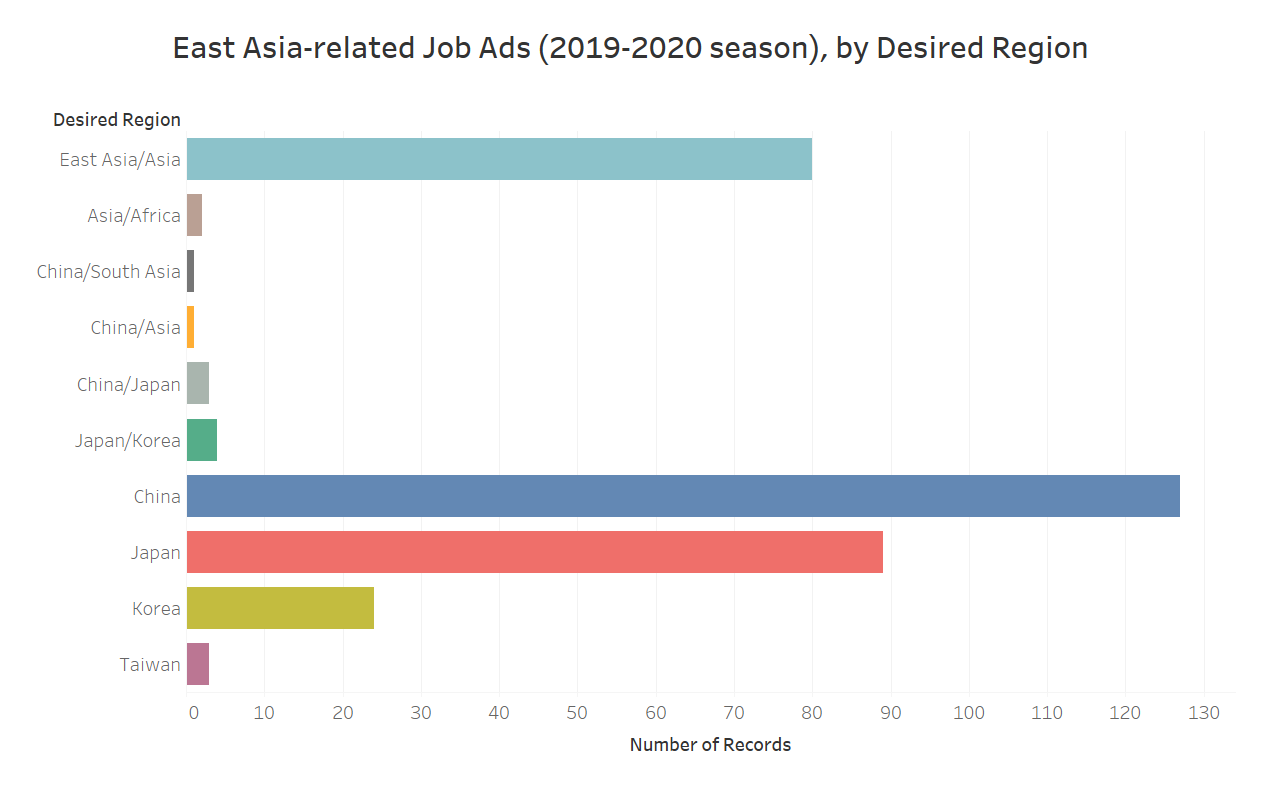
Considering all jobs, including those that do not necessarily fall into primarily academic fields, expertise in China was the leading area of interest, followed by Japan and East Asia or Asia in general.
The visualizations below provide a selection of comparative perspectives across regional and disciplinary specialization, with a focus on Northeast Asia, the humanities, and language.
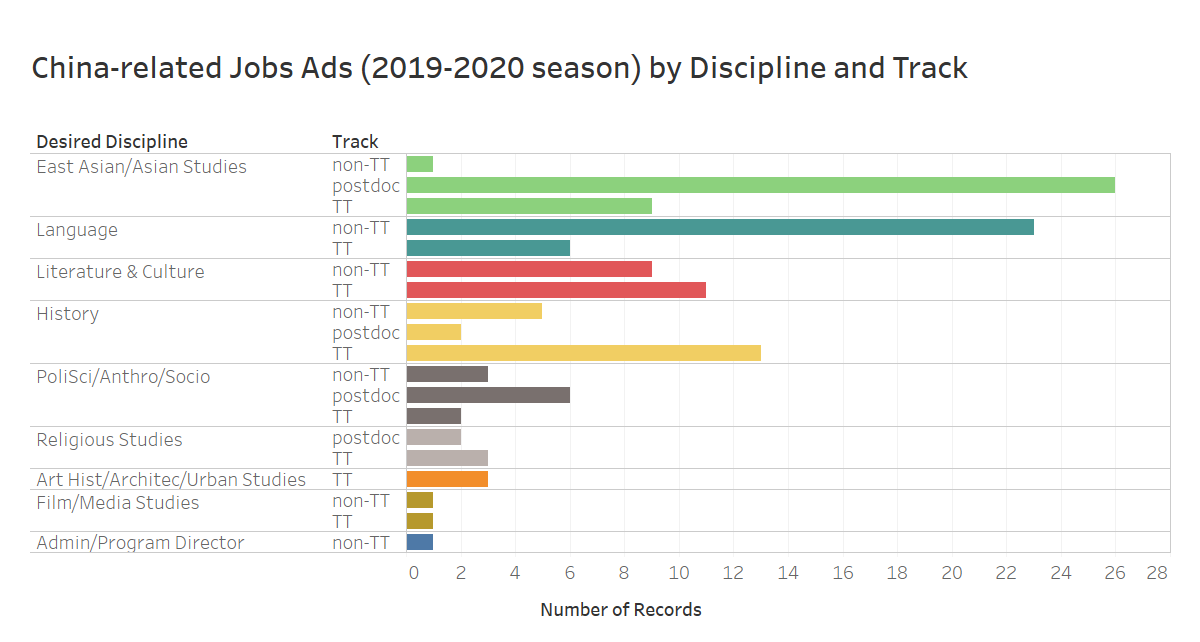
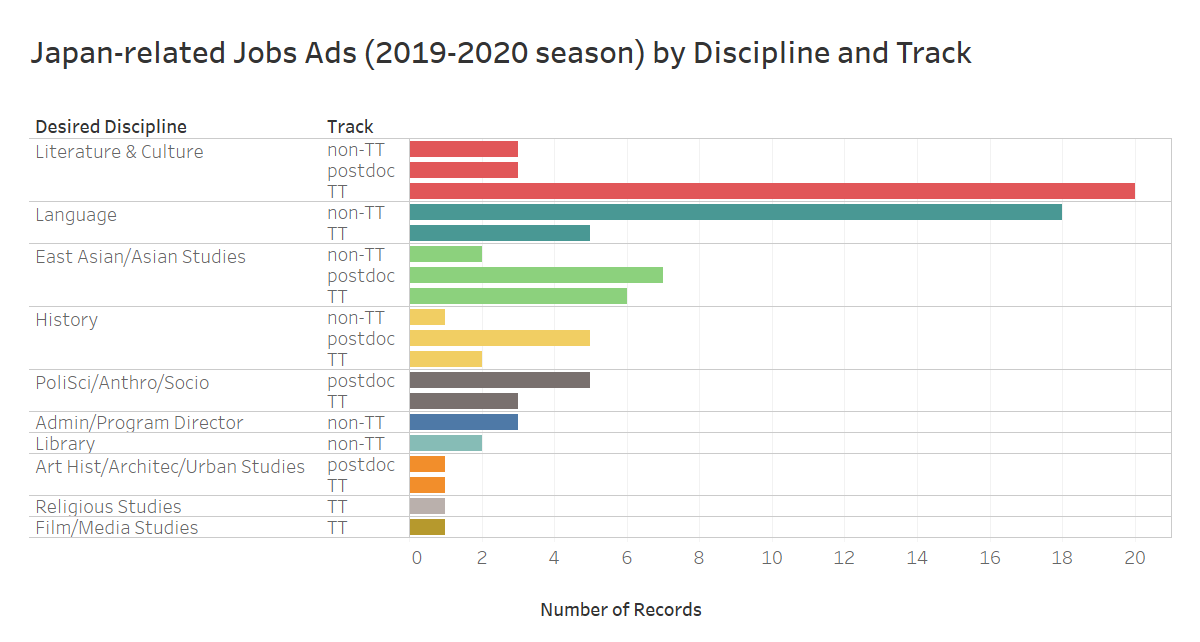
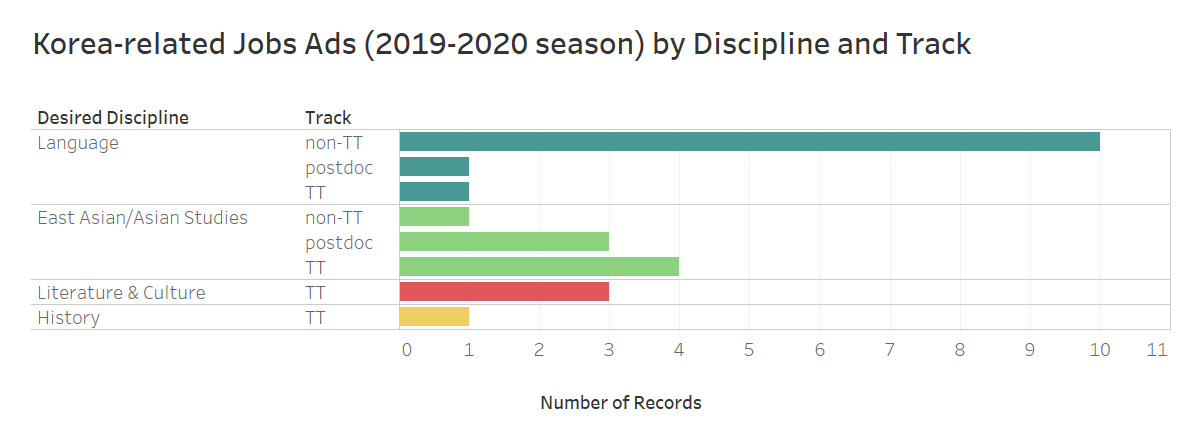
The visualizations above do not include ads seeking specialization in multiple regions. The data includes institutions across the globe. China-related job ads were most prevalent in general East Asian or Asian Studies fields (concentrated on postdoctoral research positions) and followed by language positions and literature & culture-focused jobs. Interest in literature & culture was significantly higher for Japan-related job ads, followed by language. Korean Studies, which has been growing in recent years, shows an increased interest in offering students Korean language.
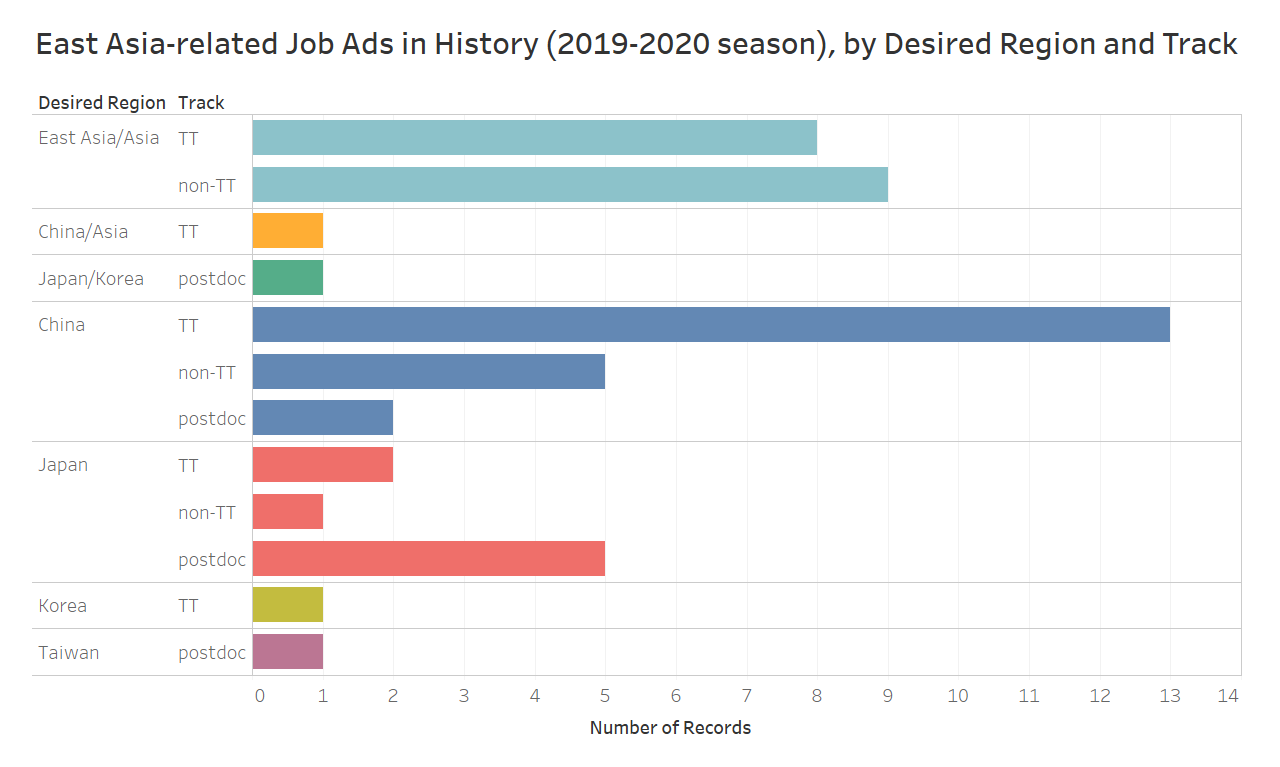
As a historian of Japan, I found it surprising that only three institutions (University of Leiden, Hiroshima University, and Pacific University) advertised explicitly Japan-focused jobs in History, though the two TT positions were outside of the US. No tenure-track faculty jobs in exclusively Japanese history were offered in North America for the 2019-2020 season.3

The above visualization combines both generalist East Asian/Asian Studies positions and Literature & Culture positions, as these frequently overlap in job advertisements. In this area, worldwide the demand for Japan specialists outstripped China in tenure-track positions, and Korean Studies shows a growing interest in the area of culture and literature. Although Korean History had only 1 TT job ad, culture/literature had 7 TT job ads. For a chart of East Asia-related job ads of this kind specifically in North America, see the visualization I created for Melinda Landeck’s roundtable statement.
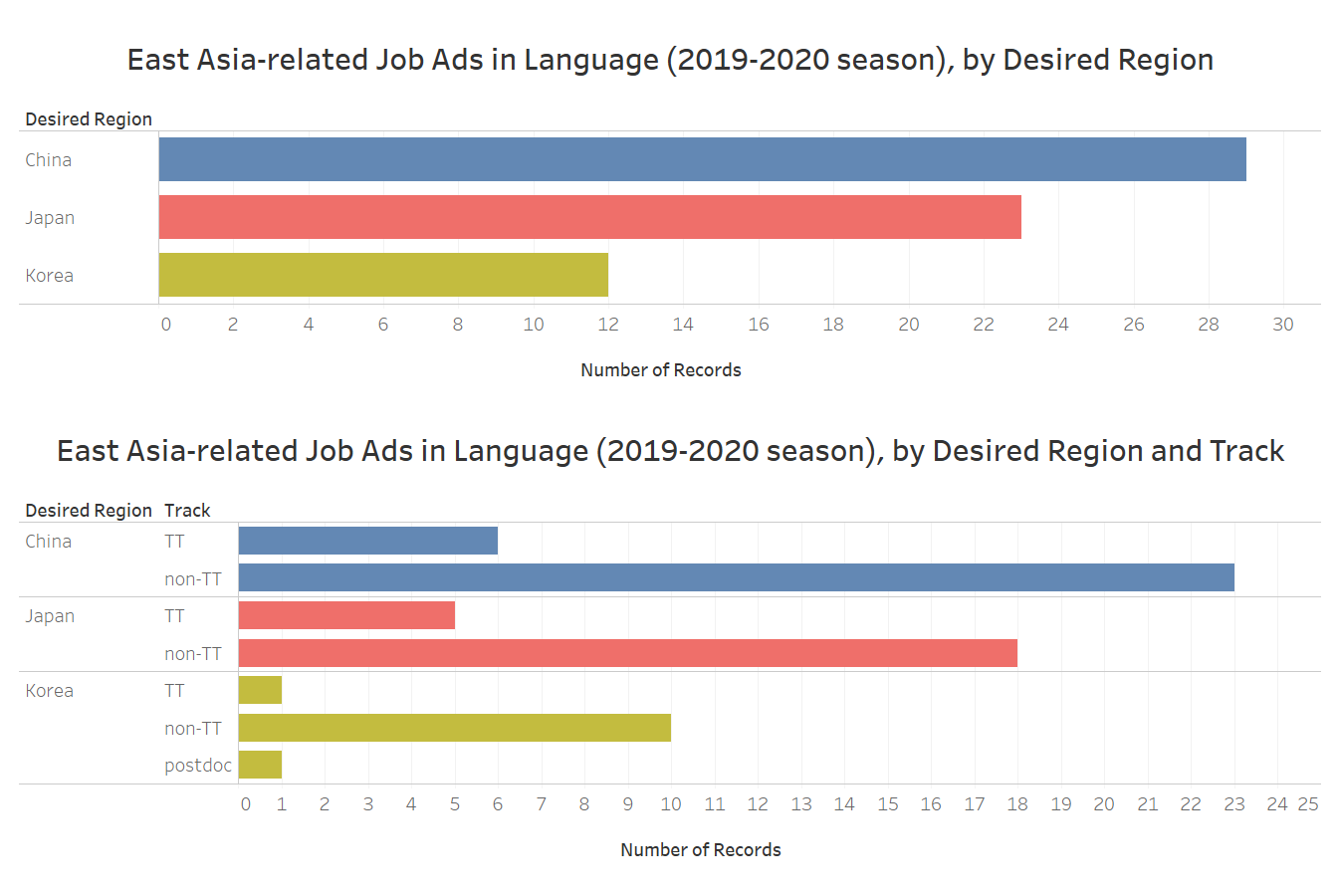
Among jobs advertisements world-wide, Chinese language was in the highest demand for the 2019-2020 season. Contingent language positions were more than triple the number of available tenure-track positions.
As for the desired time period of specialization in job ads, modern positions or positions with no stated preference dominated the 2019-2020 season across all disciplinary categories. This trend remained true regardless of tenure- or non-tenure-track jobs. For a more in-depth examination of trends based on time period of specialization, see this page.
R1 (very high research) institutions offered the most jobs for the 2019-2020 season, although this is not always the case. Filtering for US results, for example, shows that while R1 institutions offered the same number of TT (44) and non-TT positions (44) the number small liberal arts colleges offering non-TT positions (26) were double that of TT (13), which in some cases may suggest positions were being temporarily filled while seeking approval for tenure-track lines in the following year.
Overall, job advertisements for public institutions and private institutions were roughly equal. In the US, where the most jobs were advertised, private institutions exceeded public institutions.
As stated above, the ephemeral nature of job ads makes it difficult to create any meaningful comparison across job seasons, as there is no guarantee that reliable data survives for the 2018-2019 season or earlier. However, as these visualizations have shown, it is possible to compare various parameters of the 2019-2020 data with the abovementioned caveats in mind.
The outbreak of COVID-19 has had a significant impact on hiring at educational institutions, the impact of which is already being felt as job searches have been postponed or cancelled and hiring freezes implemented for the next 1-2 years (if not more). Where this will leave prospective candidates in the coming years is uncertain, and comparisons of the trends above with future data will need to take these dramatic changes into account. Nevertheless, I hope that the above information will be instructive of the particular moment in time it represents. I encourage readers to review comments by panelists on the state of the field submitted to the virtual roundtable The “Rebirth” of Japanese Studies and reflect with colleagues on these and future paths in the Japan Studies and East Asian Studies fields.
To cite this page:
Curtis, Paula R. "East Asia-related Job Market Data Report (2019-2020)," prcurtis.com, May 1, 2020; http://prcurtis.com/projects/jobs2020/
-
A special thank you to Jenna Yoshikawa, Victoria Montrose, Tristan Grunow, and others who generously helped round-out my data with their own collections. ↩
-
In particular, it was possible to locate data from the June 2019 to January 2020 period using the Association for Asian Studies job board and H-Net/H-Asia forums. A special thanks to AAS for making their older data available to me. ↩
-
Jobs ads that specified a "global" or "world" focus where Japan was listed among numerous other options (such as the York University ad) were not included here. ↩